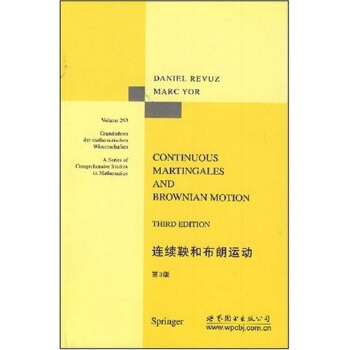![复几何导论(英文版) [Complex Geomety:An Introduction]](https://pic.qciss.net/10184579/a9d59eae-0262-48e0-a4ae-d619b4c2d831.jpg)

具体描述
内容简介
Complex geometry is a highly attractive branch of modern mathematics that has witnessed many years of active and successful research and that has re- cently obtained new impetus from physicists interest in questions related to mirror symmetry. Due to its interactions with various other fields (differential, algebraic, and arithmetic geometry, but also string theory and conformal field theory), it has become an area with many facets. Also, there are a number of challenging open problems which contribute to the subjects attraction. The most famous among them is the Hodge conjecture, one of the seven one-million dollar millennium problems of the Clay Mathematics Institute. So, it seems likely t at this area will fascinate new generations for many years to come.内页插图
目录
1 Local Theory1.1 Holomorphic Functions of Several Variables
1.2 Complex and Hermitian Structures
1.3 Differential Forms
2 Complex Manifolds
2.1 Complex Manifolds: Definition and Examples
2.2 Holomorphic Vector Bundles
2.3 Divisors and Line Bundles
2.4 The Projective Space
2.5 Blow-ups
2.6 Differential Calculus on Complex Manifolds
3 Kahler Manifolds
3.1 Kahler Identities
3.2 Hodge Theory on Kahler Manifolds
3.3 Lefschetz Theorems
Appendix
3.A Formality of Compact Kahler Manifolds
3.B SUSY for Kahler Manifolds
3.C Hodge Structures
4 Vector Bundles
4.1 Hermitian Vector Bundles and Serre Duality
4.2 Connections
4.3 Curvature
4.4 Chern Classes
Appendix
4.A Levi-Civita Connection and Holonomy on Complex Manifolds
4.B Hermite-Einstein and Kahler-Einstein Metrics
5 Applications of Cohomology
5.1 Hirzebruch-Riemann-Roch Theorem
5.2 Kodaira Vanishing Theorem and Applications
5.3 Kodaira Embedding Theorem
Deformations of Complex Structures
6.1 The Maurer-Cartan Equation
6.2 General Results
Appendix
6.A dGBV-Algebras
A Hodge Theory on Differentiable Manifolds
B Sheaf Cohomology
References
Index
前言/序言
Complex geometry is a highly attractive branch of modern mathematics thathas witnessed many years of active and successful research and that has recently obtained new impetus from physicists interest in questions related tomirror symmetry. Due to its interactions with various other fields (differential,algebraic, and arithmetic geometry, but also string theory and conformal fieldtheory), it has become an area with many facets. Also, there are a number ofchallenging open problems which contribute to the subjects attraction. Themost famous among them is the Hodge conjecture, one of the seven one-milliondollar millennium problems of the Clay Mathematics Institute. So, it seemslikely that this area will fascinate new generations for many years to come.Complex geometry, as presented in this book, studies the geometry of(mostly compact) complex manifolds. A complex manifold is a differentiablemanifold endowed with the additional datum of a complex structure which ismuch more rigid than the geometrical structures in differential geometry. Dueto this rigidity, one is often able to describe the geometry of complex manifoldsin very explicit terms. E.g. the important class of projective manifolds can, inprinciple, be described as zero sets of polynomials.
Yet, a complete classification of all compact complex manifolds is toomuch to be hoped for. Complex curves can be classified in some sense (in-volving moduli spaces etc.), but already the classification of complex surfacesis tremendously complicated and partly incomplete.
In this book we will concentrate on more restrictive types of complexmanifolds for which a rather complete theory is in store and which are alsorelevant in the applications. A prominent example are Calabi-Yau manifolds,which play a central role in questions related to mirror symmetry. Often,interesting complex manifolds are distinguished by the presence of specialRiemannian metrics. This will be one of the central themes throughout thistext. The idea is to study cases where the Riemannian and complex geometryon a differentiable manifold are not totally unrelated.
用户评价
这本书的装帧质量相当不错,纸张的触感很好,印刷清晰,即便是在光线不佳的环境下阅读,也不会感到疲劳。我特别喜欢它那种沉稳的风格,没有花哨的图饰,一切都以内容为重。这让我觉得,这本书是为那些真正渴望学习知识的人准备的。我之前尝试过阅读一些复几何相关的文章,但常常因为概念的晦涩和证明的跳跃而感到沮丧。我希望这本书能够提供一种更系统、更完整的讲解,从最基础的定义开始,一步步构建起完整的知识体系。我猜想,书中关于复向量空间、复线性映射等基本概念的介绍会非常扎实,为后续的学习打下坚实的基础。我对书中关于复解析函数与几何性质之间关系的阐述尤其期待,因为我一直觉得,复解析函数的美妙之处远不止于其代数性质,更在于它们对复空间的深刻洞察。这本书的厚度也恰到好处,既能涵盖核心内容,又不会让人望而却步,这让我有信心能够坚持读完。
评分初读这本书的序言,便能感受到作者深厚的学术功底和对复几何教育的深刻思考。他并没有直接抛出艰涩的定义和定理,而是以一种温和而富有启发性的方式,引导读者进入复几何的宏大图景。我尤其欣赏的是,作者在开篇就强调了复几何在现代数学和物理学中的重要地位,这让我对即将展开的学习内容充满了敬意和好奇。我猜想,在接下来的章节中,我们会从最基本的复数概念和复平面上的几何性质开始,逐步深入到复流形、复微分几何等更高级的主题。我很期待书中能够清晰地阐释复数与几何之间的内在联系,以及复几何如何提供一种全新的视角来理解空间和形状。我希望这本书的语言风格会是清晰、准确且富有逻辑性的,每一个概念的引入都能有明确的动机和清晰的解释。如果书中能够包含一些历史渊源的介绍,或者对一些重要定理的发现过程进行简要回顾,那将更加令人欣喜,因为它能帮助我们理解知识是如何一步步发展而来的。这本书给我的第一印象是,它并非一本堆砌公式的工具书,而是一本旨在培养读者数学思维和深刻理解的启蒙读物。
评分这本书的封面设计简洁而优雅,一看就让人联想到数学的严谨与抽象之美。书脊上的书名,"Complex Geometry: An Introduction",字迹清晰,印刷精良,透着一股沉甸甸的学术气息。我拿到这本书时,就感受到了一种期待,仿佛即将打开一扇通往未知数学世界的大门。我一直对几何学有着浓厚的兴趣,尤其是那些超越我们直观认知的复数领域。想象一下,在三维空间之上,我们还能探索更高维度的几何形态,用复数来描述它们,这本身就充满了无穷的魅力。这本书的出现,似乎正好满足了我内心深处对这种深邃知识的渴望。我迫不及待地想知道,作者是如何将如此复杂的概念,以一种易于理解的方式呈现给初学者的。我猜测,书中一定会有大量的图示和例子,来帮助我们建立直观的理解,因为纯粹的符号和公式对于初学者来说,往往是难以逾越的障碍。我希望这本书能引领我跨过这个门槛,让我领略到复几何的精妙之处,甚至能够激发我进一步深入研究的兴趣。这本书不仅仅是一本教材,更像是一次智识的探险,一次对数学宇宙的奇妙遨游。
评分翻阅目录,我看到了一些我非常熟悉的数学术语,比如“复流形”、“凯勒流形”、“霍奇理论”等等,这些词汇本身就带着一种神秘而令人着迷的光环。然而,我至今也未能完全掌握这些概念的精髓,它们对我来说,仍然是数学海洋中遥远而壮丽的岛屿。我希望这本书能够用一种循序渐进、由浅入深的方式,将这些复杂的概念一一剖析,帮助我理解它们的核心思想和相互之间的关联。我特别关注的是,作者是否能将抽象的理论与具体的几何直觉联系起来,因为缺乏直观的理解,很容易导致对理论的机械记忆,而无法真正领悟其意义。如果书中能够穿插一些精心挑选的例题,并且对解题过程进行详细的讲解,那无疑会大大提升学习效率。我也希望能看到一些关于复几何在其他数学分支,例如代数几何、拓扑学,乃至在理论物理学(如弦论)中的应用的讨论,这有助于我们认识到复几何的普适性和深远影响。这本书在我心中,代表着一段通往数学前沿的旅程,我期待它能成为我的向导。
评分拿到这本书,我立刻被它散发出的严谨气息所吸引。书页散发着淡淡的油墨香,仿佛是知识沉淀的芬芳。我个人一直对数学的抽象美有着特别的偏爱,而复几何正是这种美学的极致体现。我希望这本书能够以一种严谨而不失活泼的方式,带领我探索复数世界中的几何奥秘。我猜测,书中会对一些关键的定义和定理进行详细的推导和解释,并且会尽可能地用清晰的语言来阐述证明的逻辑。我期待书中能够包含一些关于复几何在代数和分析领域应用的例子,例如与复积分、复微分方程的联系,这有助于我们理解复几何的广泛适用性。我也希望书中能够有一些关于复几何在不同几何框架下的讨论,比如它与黎曼几何的关系,以及一些前沿的研究方向的简介。这本书对我而言,不仅仅是一本学习资料,更是一次智力的挑战,一次深入理解数学本质的契机。我渴望通过阅读这本书,能够构建起对复几何的深刻认识,并为未来的学习打下坚实的基础。
评分不错不错不错不错
评分复几何导论复几何导论复几何导论复几何导论复几何导论复几何导论复几何导论复几何导论
评分经典复几何的书籍,不错
评分经典复几何的书籍,不错
评分复几何导论复几何导论复几何导论复几何导论复几何导论复几何导论复几何导论复几何导论
评分复几何导论复几何导论复几何导论复几何导论复几何导论复几何导论复几何导论复几何导论
评分很快很满意,京东图书满300减100活动很给力
评分复几何导论复几何导论复几何导论复几何导论复几何导论复几何导论复几何导论复几何导论
评分复几何导论复几何导论复几何导论复几何导论复几何导论复几何导论复几何导论复几何导论
相关图书
本站所有内容均为互联网搜索引擎提供的公开搜索信息,本站不存储任何数据与内容,任何内容与数据均与本站无关,如有需要请联系相关搜索引擎包括但不限于百度,google,bing,sogou 等
© 2025 book.teaonline.club All Rights Reserved. 图书大百科 版权所有

![同调代数 [Homological Algebra] pdf epub mobi 电子书 下载](https://pic.qciss.net/10914295/22c00bb7-475a-493d-988e-0bea7915231f.jpg)



![代数拓扑导论 [Algebraic Topology:An Introduction] pdf epub mobi 电子书 下载](https://pic.qciss.net/10184569/1f2691de-8ab9-42ef-a71c-ae5295276dec.jpg)

![经典数学丛书(影印版):抽象调和分析·第1卷(第2版) [Abstract Harmonic Analysis Ⅰ] pdf epub mobi 电子书 下载](https://pic.qciss.net/11551547/5438761cN3a144fab.jpg)



![应用泛函分析(第2卷)(英文版) [Applied Functional AnalysisMa:In Principles and Their Applications] pdf epub mobi 电子书 下载](https://pic.qciss.net/10104517/2f5abac2-6427-4f25-b218-91904c287192.jpg)
![基础数论(英文版) [Basic Number Theory] pdf epub mobi 电子书 下载](https://pic.qciss.net/10184575/af663a0f-1dcd-436b-b472-36efed609e5f.jpg)




![有限群的线性表示 [Linear Representations of Finite Groups] pdf epub mobi 电子书 下载](https://pic.qciss.net/10096494/80e66ed0-32ef-4080-b176-3087bdeabdac.jpg)
![现代数学物理方法(第2卷) [Methods of Modern Mathematical Physics II] pdf epub mobi 电子书 下载](https://pic.qciss.net/10914333/549a7b59Nb9f42b6f.jpg)
![中外物理学精品书系·引进系列(29):等离子体光谱学导论(影印版) [Introduction to Plasma Spectroscopy] pdf epub mobi 电子书 下载](https://pic.qciss.net/11300130/rBEhWVIUU-wIAAAAAAKp_QZeitkAACR6ACZr94AAqoV532.jpg)
